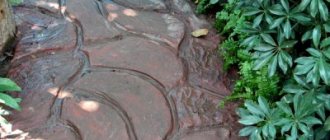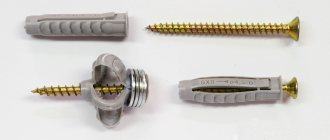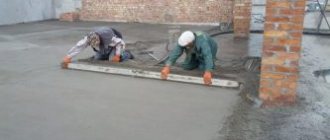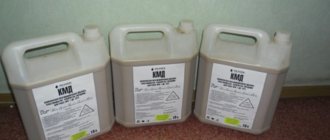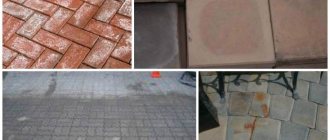Corrosion of cement stone
Not so long ago, in one of the articles, we talked about such a concept as cement stone, where we defined its main properties and characteristics. Also in this article we mentioned one of the most significant processes that affects the condition of the cement stone in the well and its ability to perform its functions - corrosion.
Corrosion of cement stone is the process of destruction of the material formed after the cement slurry hardens in the well. This destruction is caused by the impact of external factors on the body of the stone. Based on the type of factors that cause corrosion of cement stone, two main types can be distinguished: we are talking about physical and chemical corrosion of the backfill material. There are also less common varieties of it - biological and electrochemical.
Physical corrosion of cement stone assumes the presence of some factor of a physical nature as its cause. These may be temperature fluctuations or significant thermal effects, the negative influence of moisture contained in the environment, as well as destruction of the stone due to crystallization of salts. All these effects can cause significant damage, especially in areas of permafrost, where this type of corrosion process can lead to collapse of the casing after the well is shut down. Thermal corrosion included in this category is largely characteristic of objects in the form of high-temperature wells, which must be taken into account when carrying out cementing work.
Chemical corrosion of cement stone involves its destruction due to exposure to aggressive chemical environments. The water surrounding the material often contains a significant amount of dissolved salts, which create a complex multicomponent environment, and therefore, when developing protective measures, they are guided by the predominant type.
Among the less studied types of cement stone corrosion, it is necessary to highlight biological - that is, the destruction process determined by the presence of microorganisms and bacteria. Their waste products also have a negative effect on the condition of the cement stone, gradually leading to a decrease in its ability to perform its functions.
Another interesting type of cement stone corrosion is electrochemical. The so-called stray currents, which can use the casing and the stone body itself as a conductor, are capable of transporting individual ions, which also causes a special type of corrosion process.
Washing out cement stone components
This type of concrete corrosion begins due to the process of leaching (dissolution) of cement stone components. Under the influence of water on concrete, calcium hydroxide begins to dissolve first; during hydrolysis, C3S and C2S are formed and its amount gradually increases and by about 3 months it becomes about 10-15%, and the solubility is 1.3 g/l. After the process of washing out free calcium hydroxide from the cement stone. When the content decreases to 1.1 g/l, the process of decomposition of hydrosilicates begins, followed by the decomposition of calcium hydroaluminates and hydroferrites, all this leads to an increase in porosity, which means a decrease in strength. This process of concrete corrosion is greatly accelerated when it is exposed to water or pressurized water.
In order to reduce corrosion processes arising from leaching (washing out), cement with a moderate amount of C3S is used, and concrete products are specially kept in air for a long enough time so that the carbonization process begins on the surface of the concrete, which ensures the formation of a slightly soluble protective layer of CaCO3.
But the most popular way, if necessary, to combat the leaching of calcium hydroxide is to use dense concrete and add special additives to its composition that ensure the binding of Ca (OH) into a slightly soluble compound - calcium hydrosilicate.
Related articles: Density of expanded clay
Second type 2 of concrete corrosion:
Combines all processes, under the influence of which, cement stone forms various compounds
When concrete interacts with various aggressive environments, the result is the formation of joints larger than the original concrete joints, which leads to the formation of internal stress in the concrete, followed by cracking. This type of corrosion is characteristic of sulfate corrosion. Sulfates are quite often found in water, and when reacting with calcium hydroxide, they form gypsum. Concrete is destroyed due to the pressure of gypsum crystals (gypsum corrosion). This corrosion occurs due to the high sulfate content in the water.
Related articles: Concrete work in winter
Three types of cement stone corrosion, their essence, processes. Methods of protection against corrosion.
⇐ PreviousPage 3 of 3The first type of corrosion
— destruction of cement stone as a result of dissolution and leaching of some of its components. The most soluble is calcium hydroxide, which is formed during the hydrolysis of tricalcium silicate. The solubility of Ca(OH)2 is low (1.3 g CaO per 1 liter at 15°C), but from the cement stone in concrete under the influence of running soft water, the amount of dissolved and washed Ca(OH)2 continuously increases, the cement stone becomes porous and loses strength.
A protective crust of calcium carbonate, formed on the surface of concrete as a result of the reaction between calcium hydroxide and carbon dioxide in the air, somewhat protects against this type of corrosion.
Ca (OH)2 + CO2 = CaCO3 + H2O
Second type of corrosion
— destruction of cement stone by water containing salts that can enter into exchange reactions with the components of cement stone. In this case, products are formed that are either easily soluble or are released in water as an amorphous mass that does not have binding properties. As a result of such transformations, the porosity of the cement stone increases and, consequently, its strength decreases.
To the third type of corrosion
These include processes that occur under the influence of sulfates. In the pores of the cement stone, the deposition of poorly soluble substances contained in water or the products of their interaction with the components of the cement stone occurs. Their accumulation and crystallization in the pores cause significant tensile stresses in the pore walls and leads to the destruction of the cement stone. A characteristic type of sulfate corrosion of cement stone is the interaction of gypsum dissolved in water with tricalcium hydroaluminate:
ZCaO • A12O3 • 6H2O + 3CaSO4 + 25H2O = ZCaO • A12O3 • 3CaSO4 • 31H2O
In this case, a sparingly soluble calcium hydrosulfoaluminate is formed, which, upon crystallizing, absorbs a large amount of water and significantly increases in volume (about 2.5 times), which has a strong destructive effect on cement stone.
The influence of corrosion processes under the influence of various waters can be eliminated or weakened by constructive measures, by improving the technology of concrete preparation and the use of cements of a certain mineralogical composition and the required content of active mineral additives.
Polymers. Classification. Receipt. Properties.
Polymers are high-molecular compounds, substances with a large molecular weight (from several thousand to several millions), in which atoms connected by chemical bonds form linear or branched chains, as well as spatial three-dimensional structures. Polymers include numerous natural compounds: proteins, nucleic acids, cellulose, starch, rubber and other organic substances. A large number of polymers are produced synthetically based on the simplest compounds of elements of natural origin through polymerization reactions, polycondensation, and chemical transformations.
There are different classifications of polymers.
I. Based on their origin, polymers are divided into
:
· 4. Natural (biopolymers): polysaccharides (starch, cellulose), proteins, nucleic acids;
· 5. Artificial - obtained from natural polymers through their chemical transformations (celluloid, fibers: acetate, copper-ammonium, viscose).
· 6. Synthetic – obtained from monomers: rubbers, fibers, plastics.
Note: Fiber
– high-molecular substances with a linear structure and formed in the form of threads.
Rubbers
– polymerization products of alkadienes and their derivatives.
Plastics
– high-molecular compounds, which also include substances that improve the physical properties of the polymer: stabilizers (increase light resistance), plasticizers (improve elasticity, frost resistance, fire resistance), dyes.
II. Based on their composition, polymers are divided into:
· Organic;
· 2. Organic elements (polycarboranes, organosilicon);
· 3. Inorganic polymers (tin, selenium, tellurium, amorphous sulfur, black phosphorus, quartz, corundum, aluminosilicates).
III. By chemical composition
:
· Homopolymers (macromolecules contain identical structural units);
· 2. Heteropolymers (consist of different monomer residues). Such polymers are also called copolymers.
IV. According to the structure of the macromolecule:
1. Linear (highly elastic)
In macromolecules of linear polymers, structural units are sequentially connected to each other into long chains. The chains bend in different directions or curl up into a ball. It is this structural feature that gives elasticity to polymers. Among natural polymers, cellulose, amylose (a component of starch), and natural rubber have a linear structure, and among synthetic ones, low-density polyethylene, nylon, nylon and many other polymers.
2. Branched
Macromolecules of branched polymers are long chains with short side branches. For example, high-density polyethylene and amylopectin (a component of starch) have this structure.
3. Mesh (low elasticity)
Macromolecules of network polymers are long chains connected (cross-linked) by cross-links. Such a macromolecule has three dimensions in space. High-molecular compounds with a spatial structure are: wool, phenol-formaldehyde polymers, rubber.
V. By spatial structure:
A certain alternation of elementary units of different spatial configurations divides polymers into: stereoregular (or isotactic) and non-stereoregular (or atactic).
General properties of polymers (characteristic of most IUDs).
1. IUDs do not have a specific melting point, melt over a wide range of temperatures, some decompose below the melting point.
2. They are not subject to distillation, because they decompose when heated.
3. They do not dissolve in water or dissolve with difficulty.
4. They have high strength.
5. Inert in chemical environments, resistant to environmental influences.
Preparation of polymers.
Three processes lead to the formation of an IUD:
1) Polymerization reaction –
a process by which molecules of a low-molecular-weight compound (monomers) are linked to each other using covalent bonds to form a polymer. This reaction is typical for compounds with multiple bonds.
2) Polycondensation reaction –
the process of formation of a polymer from low-molecular compounds containing 2 or several functional groups, accompanied by the release, due to these groups, of substances such as water, ammonia, hydrogen halide, etc. (Capron, nylon, phenol-formaldehyde resins).
3) Copolymerization reaction –
the process of forming polymers from two or more different monomers. (Preparation of styrene butadiene rubber).
Main types of polymers and their use in construction.
Polyisobutylene
It has high elasticity, its properties are close to rubber, it is frost-resistant, and it adheres well to many silicate materials. Sealants and mastics are made from it, in particular for sealing joints between wall panels.
Polyvinyl chloride is the most common polymer in construction. Transparent, tough, durable. Softening temperature 60-100°C. Melts at a temperature of 160-200°C. They produce linoleum, pipes, finishing and building materials.
Polystyrene is a product of the polymerization of styrene gas, durable, easy to paint, and used to make foam plastic.
Polyvinyl acetate - acetic acid residue is predetermined by low water resistance. Used for the preparation of varnishes, paints, mastics.
Polymethylmethacrylate (plexiglass) is transparent, used in its pure form, in the form of sheets or blocks.
Copolymers.
Obtained by joint polymerization of several polymers.
Polycondensation polymers.
Formaldehyde phenol is obtained by polycondensation of phenol and formaldehyde. Available in the form of an oligomer. Used to produce layered plastics, waterproof varnishes, and adhesives.
Urea is obtained by polycondensation of urea or urea and formaldehyde. The cheapest and most durable in the hardened state. Disadvantage: low water resistance, prone to rapid aging. Used for paints, varnishes, laminates.
Polyesters are obtained by polycondensation of alcohols and organic acids. They are used to make paints and varnishes.
Epoxy (resin and hardener), very expensive, are used for repairing special structures.
Organosilicon polymers. In addition to the organic part, they contain silicon. Used for heat-resistant paints.
⇐ Previous3
Impact of aggressive substances on cement stone
This type of corrosion occurs when cement stone is exposed to various aggressive substances, in contact with which 2 types of compounds are formed:
- Salts
- Amorphous masses
The resulting salts are highly soluble and are dissolved (washed out) with water. Amorphous masses have virtually no binding properties (acid corrosion).
Acidic corrosion occurs when exposed to any of the acids except polysilicon and hydrofluorosilicic acid. These acids, when interacting with calcium hydroxide, create easily soluble salts CaC12, including those that constantly increase their size CaSO4-2H2O:
Ca(OH)2 + 2HC1 = CaC12 + 2H2O Ca(OH)2 + H2SO4 = CaSO4.2H2O
When exposed to such acids, hydroaluminates, hydrosilicates and hydroferrites begin to decompose, creating easily soluble salts and other additional amorphous masses.
Protection from weak acidic environments pH = 4-6 is carried out using a special acid-resistant material (covered with film, painted, etc.). If acid corrosion is strong, ph<4, then special concrete is used, which is produced using acid-resistant cement and the same acid-resistant fillers; if necessary, concrete with polymer components of the binder material is used.
Carbon dioxide corrosion is a type of general acid corrosion that occurs under the influence of water on concrete, which contains free carbon dioxide, as weak carbonic acid, above normal. This increased content of aggressive carbon dioxide destroys the previously formed carbonate film due to the formation of highly soluble calcium bicarbonate.
Corrosion of concrete when exposed to various organic and inorganic acids. Various oils that contain fatty acids (linseed oil, fish oil, etc.) also have a very bad effect on concrete. And in turn, oil and all its production products, such as gasoline, oil, kerosene, etc., do not harm concrete at all, provided that they do not contain residual acids, but you need to know that they penetrate inside the concrete quite easily.
Related articles: Expanded clay weight
